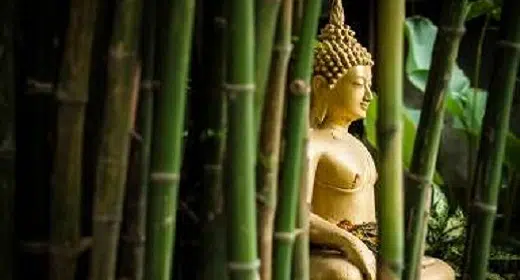by Sonia Mehta: Nirvana, according to Buddhism, is the state in which the mind is at complete peace and the soul is merged with the universe… 
It is reached when a person’s desires and suffering all go away and they need nor want nothing.
After wandering around for days and nights, Gautama found himself near a large peepul tree.
Something about the tree called out to him. He made a resolution. ‘I shall sit under this tree and meditate upon my questions. And I shall not move until I have my answers. Even if my skin rots and my body decays, I shall not budge till I see the light,’ he decided.
He sat in the lotus position, closed his eyes and concentrated on his breathing. As the night passed, he went through many different feelings.
The Temptation of Mara

(Source: Puffin Books)
First, the evil demon Mara came to him. Mara tried his best to tempt Gautama away from his pursuit. He painted pictures of wealth and beauty. He tried to scare him with awful images of starvation and death. But Gautama remained steadfast, not tempted nor scared. Finally, Mara gave up and went away.
Gautama sat deep in profound meditation. He felt as if he was floating.
Suddenly, he could see the world as if from far, far away. He saw himself. He saw that he had died many times before and that he had been reborn each time. He saw all his past lives. He saw all the things he had done in his lives—the good as well as the bad. And finally, he realized something.
The Enlightenment

(Source: Puffin Books)
Gautama realized that people are born again when they desire things. Specifically, the bad things they do in their former lives cause them to come back to earth in a new life, as if to correct them. But the people who realize this and free themselves of desire—those who want nothing from life—are finally free from the cycle of birth and death. That’s when they reach nirvana, the perfect heaven.
Of course, all this was in Gautama’s mind while his body sat still, which seemed to glow brilliantly from within. At that moment, Gautama had become a Buddha. He had seen the light.
Oh Really? The peepul tree under which Gautama saw the light is called the Bodhi tree. It still stands tall in present-day Bihar, in a place called Bodhgaya. Buddhists from all over the world continue to visit it as it is one of the most holy spots for them.
What Is Nirvana?
Nirvana, according to Buddhism, is the state in which the mind is at complete peace and the soul is merged with the universe. It is reached when a person’s desires and suffering all go away and they need nor want nothing.
The Next Seven Weeks
For the next seven weeks, the Buddha continued to sit in silence, allowing his mind and spirit to understand what he had just seen.
During the first week, the Buddha was happy and content, feeling true peace for the first time.
OH REALLY? Even now, it is customary for Buddhists to pay homage to the Bodhi tree that canopied the Buddha, as well as the offshoots of the tree.
During the second week, he felt a deep gratitude to the peepul tree that had sheltered him as he’d sought the light.
During the third week, the Buddha saw the devas. Not sure if they were indeed gods, he built a golden bridge in the air and walked across it to the heavens.
During the fourth week, he created a special chamber in which he meditated. His mind and body became so pure that it is said to have radiated bright rays in six different colours—blue, orange, red, white, yellow and a combination of these five colours. These colours stood for purity, confidence, wisdom, the lack of desire and holiness. The five colours together stood for all these qualities.
Did You Know? The Buddhist flag is in these six colours.
During the fifth week, three beautiful girls appeared, who tried their best to distract the Buddha and lure him away from his thoughts. Their names were Raga, Rati and Tanha. But no matter how much they tried, the Buddha remained unmoved.

(Source: Puffin Books)
During the sixth week, the Buddha went to meditate at the foot of the Mucalinda tree. It began to rain and the air was freezing. That’s when an enormous king cobra called Mucalinda appeared and coiled himself around the Buddha seven times. Then he raised his hood and covered the Buddha, keeping him warm and dry.
During the seventh week, two merchants called Tapussa and Bhallika appeared. The Buddha, seated under the Rajayatana tree, had been fasting for forty-nine days by then. They brought rice cakes and honey to help him break his fast. When the Buddha explained what he had experienced, they were entranced. They became his first ordinary followers, and the Buddha gave them a strand of hair from his head as a token.
Oh Really? The strand of hair that the Buddha is said to have given Tapussa and Bhallika is enshrined in a Buddhist pagoda in Yangon, Myanmar.
(Excerpted with permission from Junior Lives: Gautama Buddha, authored by Sonia Mehta, published by Puffin India 2018. MRP: Rs. 150.)









































